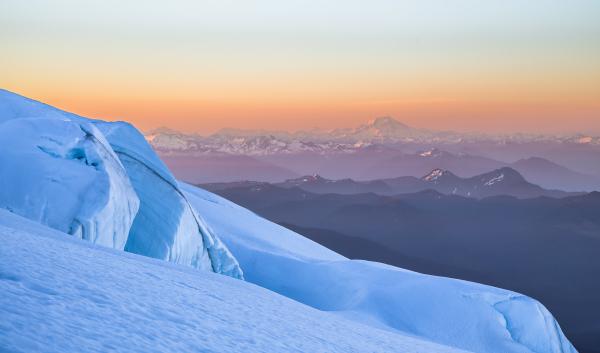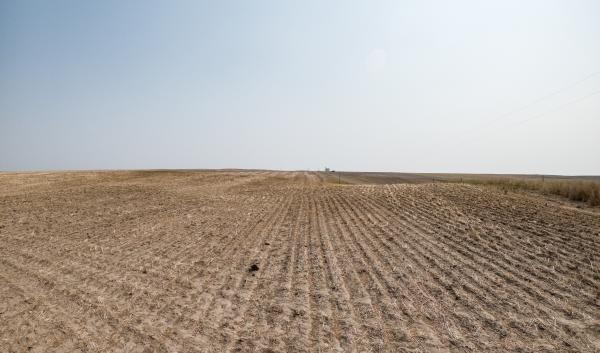Reading time: 8 minutes
Here at the Northwest Climate Hub, we recognize that the effects of climate change may have caused damage or distress to many of our readers. Reading about climate change may be triggering, so if you are suffering from mental health impacts because of climate change, please reach out to the Disaster Distress Helpline.
Key Points
- Drought occurs when there is a mismatch between moisture supply and demand, and can be short-term or long-term. There are many definitions of drought.
- While lack of precipitation can trigger droughts, in some places, rising temperatures have become a bigger factor in drought severity in recent decades.
- Drought can have negative effects on many facets of the regional culture, economy, and ecology.
- Experts use physical data, satellite imagery, and computer models to determine when a region is experiencing drought.
- Not every drought is directly caused by climate change. Some droughts are caused by normal changes in weather patterns over time, or by weather phenomena like El Niño.
Fresh water forms the foundation for a thriving tapestry of life in Idaho, Oregon, and Washington. From iconic salmon navigating streams to bears, osprey, and deer dependent on riparian habitat, water is paramount to the ecological integrity of the region. Fresh water also fuels the economic engine of the Northwest. Aquifers, wells, and reservoirs provide drinking water for communities and support a robust agricultural industry. Snowpack provides enough soil moisture to support dryland agriculture, as well as vegetation and wildlife, throughout the year. Countless visitors recreate on waterways in the region, boosting local economies. Furthermore, adequate fresh water is integral to the cultural practices and food security of Native Americans in the region.
Drought is a natural occurrence in the Northwest. However, climate change could increase the duration and severity of drought, which could have negative effects on the ecology, economy, and culture of the region.
The relationship between drought and climate change

Drought is a prolonged period of abnormally dry conditions that result in water shortages. It can have significant consequences across sectors, including agriculture (e.g., reduced crop yields, decreased soil moisture), hydrology (e.g., lower streamflow and reservoir levels), and socioeconomic conditions (e.g., reduced fisheries output, increased food costs, decreased hydroelectric power). The severity of drought is dependent on its intensity, duration, type, and location. For example, a one-year drought in the temperate rainforests of northwest Washington will manifest differently than a 10-year megadrought in the hotter, drier Snake River Plain of southern Idaho.
Unlike sudden natural disasters such as floods or wildfires, drought typically develops gradually and can last for months to years. This can make it challenging to pinpoint the exact beginning and end of a drought. Consequently, it can take weeks or months to conclusively identify drought conditions. One of the most-recognized signs of drought is below-average precipitation over a prolonged period. Other indicators include decreased soil moisture, reduced streamflow and reservoir levels, and lower water levels in wells and aquifers.
Heat drives western U.S. droughts
Regional temperatures have already risen nearly 2°F since 1900. By the end of the 21st century, climate change is projected to raise regional temperatures by 4.7–10.0°F. Since 2000, high temperatures have actually played a larger role in drought severity than lack of precipitation. For example, evaporation associated with higher temperatures accounted for 61% of the 2020 to 2022 drought's severity, whereas reduced precipitation only accounted for 39%. This is because hotter temperatures cause increased evapotranspiration, or the loss of water from the soil both by evaporation from the soil surface and by transpiration from the leaves of the plants growing on it. With higher temperatures, plants have to acquire and transpire more water than they do in cool conditions (think of this like humans having to drink more water when it is hot). This is known as increased evaporative demand. A higher evaporative demand means less moisture can be stored in the soil and in plants themselves. This can stress plants, and even cause plant death.

Though recent trends show that heat influences drought severity more than lack of precipitation, precipitation does play a role in drought. In the Northwest, precipitation is actually projected to modestly increase. However, more winter precipitation is likely to fall as rain rather than snow, and summer precipitation is projected to decrease. Alongside rising temperatures, reduced snowpack, and earlier snowmelt, changing precipitation patterns can limit the water available for plants, people, and wildlife during the driest and hottest parts of the year, leading to drought.
Several long-lasting and severe droughts have occurred in the Northwest in recent years, including in 2001, 2015, and 2020–2022. Some subregional areas, including southern Oregon and southern Idaho, have been in a megadrought—a multi-year drought that stands out as especially extreme in severity, duration, and size when compared to other droughts of the last two thousand years. Below the 45th parallel (most of Oregon and southern Idaho), 2000–2021 was the driest 22-yr period since 800 CE. As temperatures continue to rise and precipitation patterns change, the region could see longer and more severe droughts in the future.
Drought occurs when there is a mismatch between moisture supply and demand, and can be short-term, lasting fewer than six months, or long-term, lasting longer than six months. There are many definitions of drought. The following are some of the most common definitions:
- Meteorological drought refers to a period in which drier-than-average or warmer-than-average weather patterns occur in a location.
- Hydrological drought occurs when low water supply becomes evident in the water system. Examples include low streamflow, reservoir, and near-surface groundwater levels.
- Agricultural drought occurs when crops are affected by the reduction in precipitation, excessive evapotranspiration, or inability to irrigate. Examples include reduced crop yield and size.
- Ecological drought is when natural systems, such as forests and rangelands, are affected by reduction in precipitation. Examples include tree die-offs and reduced forage.
- Socioeconomic drought occurs when the supply and demand of commodities are affected by the reduction of precipitation. Examples include limited hydropower generation or reduced grain prices associated with drought.
Idaho, Oregon, and Washington also experience snow drought. Snow drought can occur due to a lack of precipitation (meteorological drought) or when temperatures are high and winter precipitation falls as rain instead of snow, affecting snowpack (hydrological drought). Recent research indicates that from 1980–2018, snow droughts became longer and more intense in the western U.S. (including Idaho, Oregon, and Washington) due to rising temperatures. Snow drought can have detrimental effects on people and wildlife in the Northwest. For example, during the 2015 snow drought, agricultural losses in Idaho, Oregon, and Washington reached nearly $1 billion, fish populations fell, and wetlands shrank. Additionally, snow droughts increase wildfire risk at higher elevations. Events like the 2015 snow drought offer a glimpse into the potential future of Northwest winters in a changing climate.
Flash droughts—droughts that emerge or intensify rapidly—can also occur. Flash droughts are caused by lower-than-normal rates of precipitation accompanied by abnormally high temperatures, winds, and solar radiation. In the Northwest, these conditions most often occur during summer heatwaves. Flash droughts can rapidly affect crops, forests, fisheries, livestock, and other resources. With rising temperatures and an more frequent and intense extreme heat events, flash droughts could become more common.
Not every drought is directly caused by climate change. Some droughts are caused by normal changes in weather patterns over time, or by weather phenomena like El Niño. Droughts can occur once a year, every few years, or every few decades, can last for varying amounts of time, and can occur at different intensities. This can make it difficult for scientists to distinguish between individual events that occur randomly, and events that are influenced by climate change. However, recent events and climate projections suggest that droughts will become longer and more severe in the future in association with climate change.

Many tools are used to evaluate drought, including physical data (e.g., soil moisture, plant health, water levels), satellite imagery, and computer models. Using this and other information, regional- and state-level experts create a weekly map of drought conditions for the U.S. Drought Monitor (USDM). The map identifies areas in drought and labels them by four categories in order of increasing severity:
- Moderate drought (D1 – tan on the map)
- Severe drought (D2 – orange)
- Extreme drought (D3 – red)
- Exceptional drought (D4 – maroon)
The map also shows areas with no drought (white) and uses the abnormally dry category (D0 – yellow) to indicate areas that could be entering or recovering from drought. The USDM also labels short-term drought (S), long-term drought (L), and short- and long-term drought conditions (SL).
State, federal, and tribal resources for drought relief tend to be made available once an official declaration of drought is made. Each state has different drought thresholds. For example, Washington declares drought when the state’s water supply falls below 75%, whereas Idaho and Oregon have more case-based specifications for drought declaration. In Idaho and Washington, individual counties can also request drought declarations from their state government to receive drought relief funds and tools. In Oregon, counties can petition for drought declaration. Once declared by the governor, the Oregon Water Resources Department can then temporarily authorize increased access to surface or groundwater and other tools.
How can drought affect Idaho, Oregon, and Washington?
The region relies on rain, snowpack, groundwater, and rivers (e.g., Columbia and Snake Rivers and their tributaries) for agriculture and water supply, ecosystem and human health, energy production, and tourism. As such, drought can have negative effects on many facets of the regional culture, economy, and ecology.
Idaho, Oregon, and Washington are large states with diverse ecosystems and climate influences. As such, no two states or even counties are identical when it comes to the effects of drought. However, below are some examples of drought impacts experienced in these states since 2005, determined from analyses of impact reports in the region. To see more examples, visit the U.S. Drought Monitor State Impacts Tool.
| Drought category | Examples of historically observed effects of drought |
|---|---|
D0 – abnormally dry |
|
D1 – moderate drought |
|
D2 – severe drought |
|
D3 – extreme drought |
|
D4 – exceptional drought |
|
Preparing for future droughts
Possible increases to the duration and severity of droughts in a changing climate could affect water availability in Idaho, Oregon, and Washington. However, there are adaptation actions that can help people build resilience to drought. Water managers, policymakers, and residents alike can consider implementing water conservation measures, developing drought contingency plans, and investing in drought-resilient technologies and practices. Residents and water managers can also become more drought-aware by staying up to date with current drought conditions on the U.S. Drought Monitor webpage.
The Drought Impact Reporter Dashboard from the National Drought Mitigation Center displays media-based drought impacts on a map, which the National Drought Mitigation Center has been systematically collecting and recording since 2005.
The Flash Drought Tool is a NOAA National Weather Service Climate Prediction Center tool to better predict areas at risk for flash drought development.
The Overview of Weather Water Land Sites (OWWLS) is a static map that shows locations of weather and water monitoring stations used by the U.S. Drought Monitor to assess current drought conditions.
-
Drought and Northwest Agriculture in a Changing Climate
Climate change could cause agricultural droughts to become longer and more severe in Idaho, Oregon, and Washington.
-
Snow Drought in the Northwest
Snow droughts have become longer and more intense in the Northwest since 1980, a trend which will likely continue with climate change.
-
Extreme Weather: Northwest Drought
Drought affects agriculture, forests, rangelands, and people throughout the Northwest with increasing frequency and intensity due to climate change.




